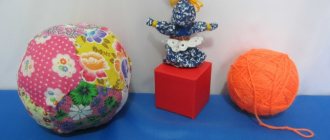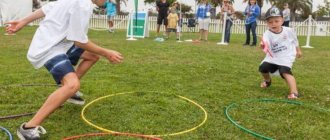Already at an early age, children need to develop the correct attitude towards traffic rules, since they are the norm of behavior of every modern person. In preschool educational institutions, children are given the necessary knowledge, skills and abilities regarding how to cross the road, behave on the street and in public transport. The life and health of the child will depend on the degree of assimilation and implementation of traffic rules.
In the first place in the entire process of teaching children are gaming technologies, with the help of which it is possible to organize various types of children's activities and maintain the constant interest of preschoolers in learning traffic rules. The ability to play is a mandatory indicator of the culture of both an individual and society as a whole.
Games on traffic rules in kindergarten
Goals and objectives of traffic rules games for preschool children
The main goal of organizing lessons on learning the rules of the road is for the little ones to acquire theoretical knowledge, and in their heads to develop stable practical skills on how to protect themselves on the street and on the road.
In order to achieve this goal, it is necessary to implement a system of training, development and educational tasks. Educational tasks are represented by broadening one's horizons on issues of safe behavior on the road, studying traffic rules for pedestrians and passengers, mastering the terms and concepts that are used in road traffic and contribute to the successful acquisition of the basics of safe behavior in the future. As for educational tasks, they are as follows:
- formation of a road traffic member culture;
- fostering a negative attitude towards everyone who violates norms of behavior and traffic rules.
Note! Developmental tasks mean the development of independence and the ability to organize one’s activities while driving in such a way that it is rational. Also, during developmental activities, the child develops logical and spatial thinking, imagination and memory.
Game form of lessons on traffic rules in younger groups
It is recommended to start a lesson with the youngest preschool children (1.5-2 years) on the topic of road transport concepts with a walk down the street. The teacher must show the tiny pedestrians the sidewalk, the roadway and must tell them about their purpose (it is not necessary to go beyond the preschool). Children will become familiar with concepts such as passenger, driver and pedestrian, while simultaneously observing how vehicles move on the road. As a visual aid, consider a car that delivers food to the kitchen every day and discuss how this road is constructed.
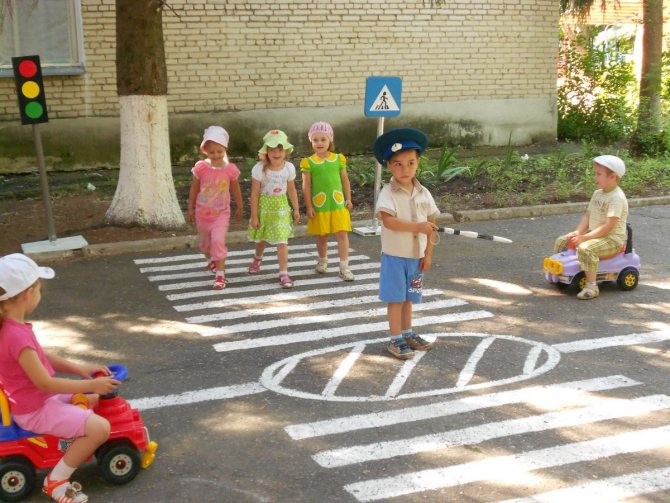
Learning the rules with children outside
During group lessons, experts recommend resorting to the technique of modeling different road situations as often as possible. The teacher should encourage pupils to play with toy cars, pronounce each action out loud and encourage preschoolers to do this (for example, the vehicle reduced speed, reversed or turned right).
Game form of classes in middle groups
In the middle group of kindergarten, all traffic rules games for preschoolers are aimed at learning and practicing traffic rules. The didactic game method is mainly used here. The mandatory points of this method are:
- rules;
- clear and consistent game actions;
- a precisely defined result.
Important! The educational form of classes is presented in 2 types: focusing on the content of game actions or on the props with the help of which the storyline of the game is built.
Game form of classes in senior groups of preschool educational institutions
As a basis for lessons on traffic rules in older groups of kindergarten, personal social skills of interaction with the outside world are used, and behavior patterns are also copied on toys or peers who also participate in the game. For example, in the game “Bus” in the senior group, students must take turns entering the “transport”, then buy tickets from the conductor and ask the driver to stop at one stop or another.
Making a model according to traffic rules in kindergarten with your own hands
Game form of classes in preparatory groups
With children 6-7 years old who go to the preparatory group, you can already play theatrical games, implemented in two forms. As a rule, teachers use dramatization, that is, the participants in the game become “artists” who play roles according to the script. You can also resort to director's play, where children direct the movements and actions of characters - dolls.
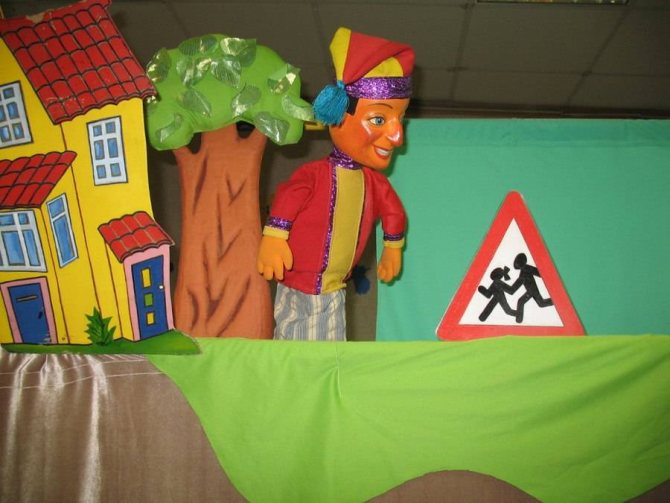
An example of a doll for traffic rules classes
Types of games based on traffic rules
Since gameplay is the leading activity for preschoolers, with its help children quickly learn what can be done on the road and what actions are prohibited. For this reason, lessons on studying traffic rules are included in programs according to which the educational process is implemented in preschool institutions.
Outdoor games in the senior group according to traffic rules
In the process of active gameplay, children develop skills to act in conditions that are constantly changing, and to instantly respond to unexpected situations. Outdoor lessons develop the following motor skills in toddlers:
- determination of distance (far - close);
- speed (fast - slow);
- dimensions (more - less);
- visibility (whether the car is obscured).
The child must coordinate his actions with the movements of surrounding people and record the movements of objects.
Didactic games in the senior group on traffic rules
In order to conduct lessons on learning the rules of the road, you must, of course, stock up on visual material in advance. The props can be represented by the main signs with which traffic is regulated, images of a traffic controller, a street map with pedestrian crossings and buildings. In the process, children learn signs and rules of behavior.
Role-playing
With the help of role-playing lessons, the preschooler engages in free improvisation and forms a model of social relationships, acting out various situations. Role-playing entertainment always involves playing “something” or “someone,” and their distinctive characteristic is the presence of a script and roles.
Note! You can play with children on the territory of a children's automobile playground, which must be in a kindergarten, or in a room with special layouts and a magnetic board.
Interactive
The use of various multimedia tools has become almost the most important innovation in the work of kindergarten teachers. Methodological tools and techniques of educators were diluted with information and communication technologies, which made it possible to make lessons for children more exciting and memorable. Today, the method of interactive games is popular, relevant and effective, and teachers quite often use presentations to study traffic rules.
Puzzles, dominoes, board games
With the help of the unusual “Road” domino, the child will always be able to apply all the knowledge he has acquired about road signs in practice, as well as study traffic lights and road markings. Participants in the entertainment must work together to build their own road, correctly connecting the cards to each other.
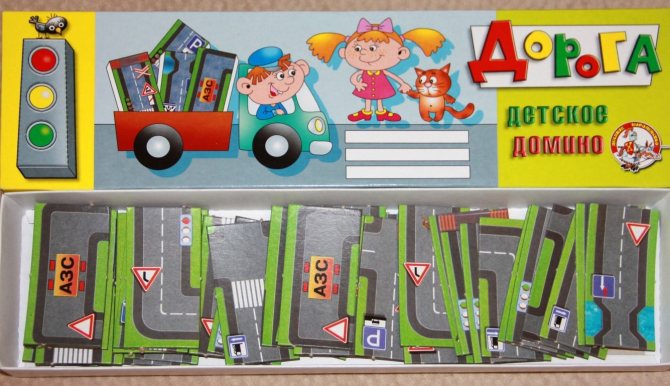
Domino "Road"
Note! To study the most common traffic signs, experts recommend using a children's plastic lotto “Traffic Signs”, on the chips of which signs are drawn, and their decoding is written on the cards.
Lesson plan on the topic “Transport” in the preparatory group
Card index of didactic games on traffic rules for preschool children
Yulia Fedoseeva
Card index of didactic games on traffic rules for preschool children
Every day the flow of vehicles on the streets is increasing and increasing. In such situation
It is important to teach children the rules of the road, because nothing can be more important than the health and life of a child, his safety. What is the best way to convey traffic rules knowledge to young pedestrians? Of course, in the form of a game, since it is the main means of teaching preschoolers.
I offer you several didactic games that the students of our group enjoy playing.
Didactic game: “Cut signs”
Objectives: Develop the ability to distinguish road signs and form a whole from individual elements; fix the name of road signs; develop logical thinking and eye in children.
Material: Split signs.
Progress of the game:
The child is first asked to remember which traffic signs he knows, and then asked to assemble the cut signs from memory.
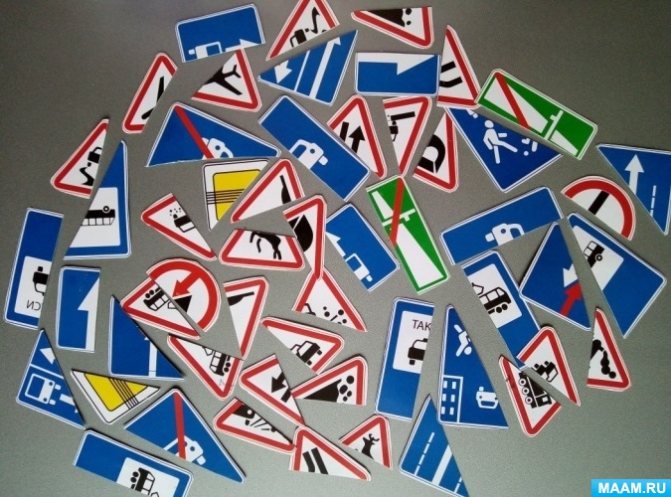
Didactic game: “Learn to be a pedestrian”
Objectives: To consolidate children's knowledge of the road alphabet; learn to recognize traffic signs necessary for pedestrian safety on the road.
Material: cards with images of road signs.
Progress of the game:
The child is asked to choose from the proposed signs those that will allow him to cross the road safely.
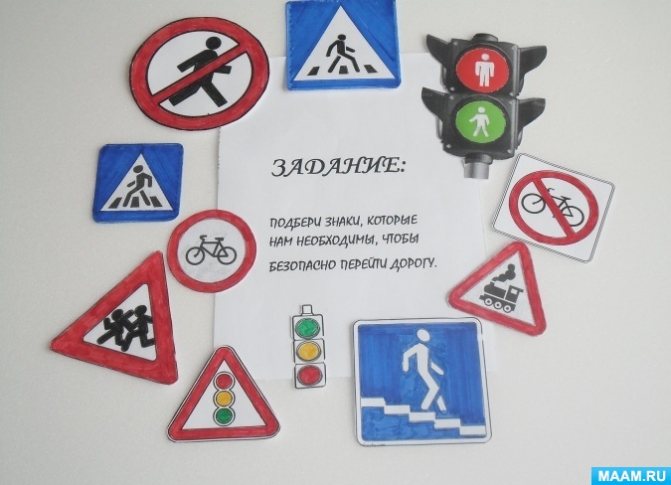
Didactic game: “Repair the traffic light”
Goal: to consolidate children’s knowledge about traffic lights, the ability to create a whole image from individual elements.
Material: cut traffic light template, red, yellow, green circles.
Progress of the game: The teacher explains to the children that the traffic light is broken, it is necessary to repair the traffic light and correctly assemble it according to the color of the traffic light signal. Children make a traffic light template and put circles on the finished template.
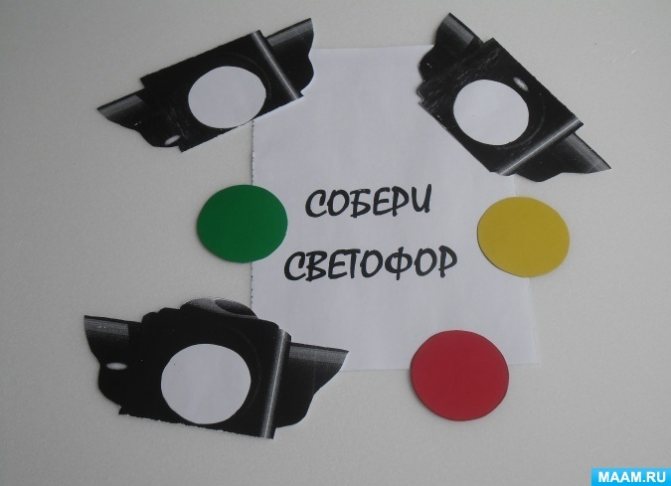
Didactic game: “Road markings - Zebra”
Goal: to consolidate children’s knowledge about pedestrian crossings (zebra crossings, signs and rules for safe crossing (with an adult).
Material: Black and white stripes.
How to play: Alternating black and white stripes, you need to lay out the type of road markings that indicate a pedestrian crossing - Zebra
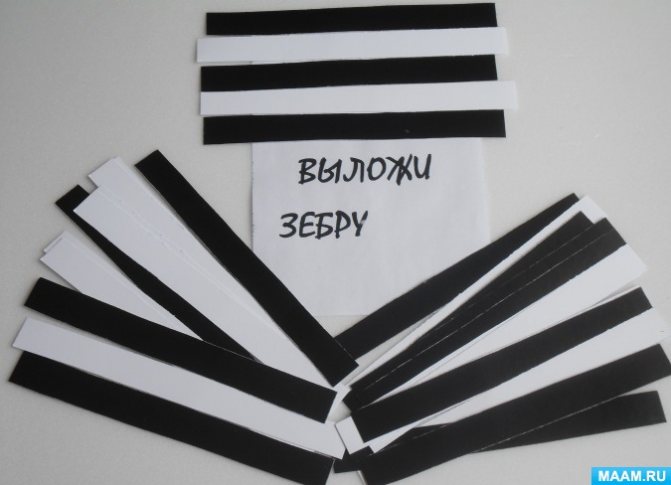
Didactic game: “Traffic light”
Goal: to consolidate children’s ideas about the purpose of a traffic light, about its signals, to develop attention and visual perception; cultivate independence, speed of reaction, and ingenuity.
Material: Card - table, picture depicting a traffic light with a red, yellow, green signal.
Progress of the game: The presenter reads a poem or riddle about a traffic light signal. The child, having guessed the riddle, takes the traffic light with the signal mentioned in the poem and places it in the desired window of the table.
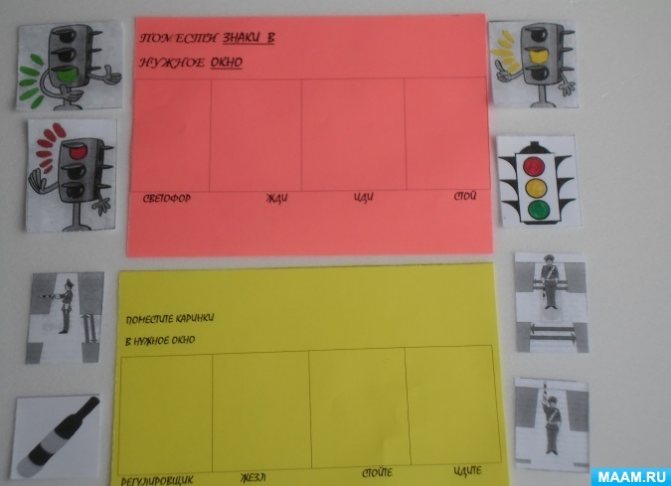
Didactic game “Guess which group the road sign belongs to?”
Objectives: To teach children to distinguish road signs, to consolidate children’s knowledge of the rules of the road; develop the ability to independently use the acquired knowledge in everyday life.
Material: cards with images of road signs: warning, prohibiting, permitting and service signs. “Permissive”, “Prohibiting”
Progress of the game:
1st option. The presenter invites you one by one to the table where the rolls lie. Invites the child to take a “permissive sign.” The child takes a card, names the sign and approaches the children who already have signs of this group.
2nd option. The presenter shows a sign. Children find this sign on their cards, show it and tell which group it belongs to.
3rd option. The players are given cards. The children study them carefully. Next, each child talks about his sign without naming it, and the rest guess this sign from the description.
4th option. The presenter reads poems or riddles about road signs,
whoever guesses it gets this sign. The child who collects the most characters wins.
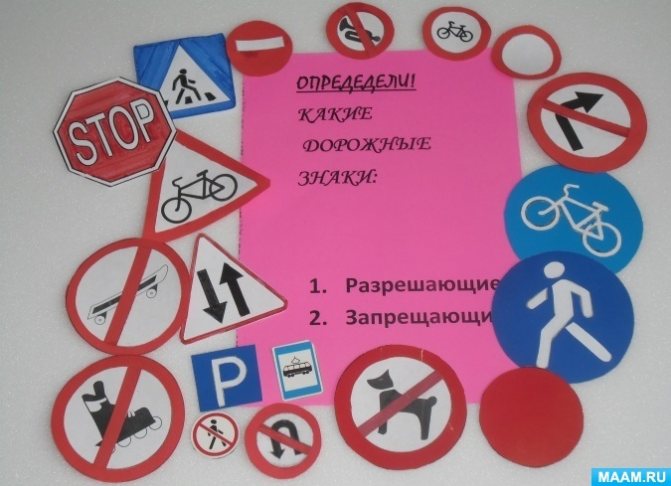
How to make a traffic rules game with your own hands
You can make a game for learning the rules of the road with your own hands, without making any special efforts. An example of self-production can be seen in the tabletop entertainment called “What First, What Then.”
First you need to build playing fields from white A4 cardboard, which should be cut lengthwise into two halves. Each half must be divided into three parts and numbered from 1 to 3 (six playing fields will be enough). Using a computer online, you should find an image of a situation on the road that requires performing certain actions in accordance with the road sign.
At the final stage of production, in the Paint computer program, you need to draw a game character (Dunno, Little Red Riding Hood or any other) on the picture. By placing the character in different parts of the image, an algorithm of action on the road is obtained.
The preschooler's task is to place the pictures in the correct sequence.
Note! During the lesson, the future road user simulates the situation and determines the required algorithm of actions, writing everything down in a notebook.
Card index of games on traffic rules for preschoolers with goals
The traffic rules card file in the middle group according to Federal State Educational Standards (federal state educational standards) with goals includes such entertainment as “Guess what sign?”, “Drivers” and “On the Road”.
"Guess what sign"
The purpose of the “Guess Which Sign” lesson is for children to consolidate their knowledge of traffic rules and independently use them in everyday life. The gameplay is represented by cubes with directional, warning and prohibition signs stuck on them in a checkerboard pattern.
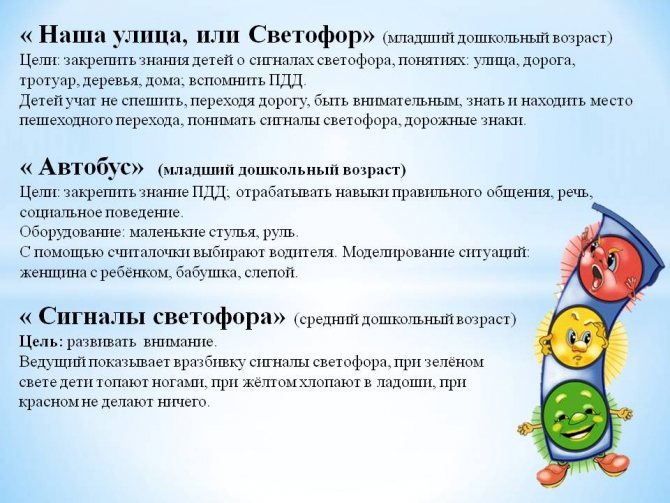
Traffic rules in the second junior group - a card index with goals
The teacher should take turns inviting the children to the table where the cubes are laid out. The student takes a cube, names the sign and goes to the group of children who already have symbols of this variety.
"Drivers"
In the process of educational entertainment "Drivers", the little ones also learn the rules, but in addition to this, they also develop thinking and spatial orientation. To conduct a lesson, you need to stock up on playing fields, toy cars and other toys. The teacher prepares 3-4 options for playing fields in advance, each of which is represented by a picture with signs. This is necessary to change the traffic situation.
For example, a kid becomes a car driver, and he needs to take the fox to the store, get gas and repair the car. The image of the vehicle represents the garage where the little one left and where he must return. The child needs to think and say in what order these points should be visited so that the traffic rules are not violated.
"On the way to"
Thanks to the lesson “On the Road”, students consolidate their knowledge about types of transport, train their memory and attention. To play the game you will need images of cars and trucks, as well as chips. The game is played outdoors, but before starting you need to agree with the children who will collect what type of cars. During the game, the little ones pay attention to the cars, name them and receive chips for each correct answer. Whoever has the most chips at the end is declared the winner.
Note! Based on all of the above, we can conclude that it is easiest for preschoolers to perceive information about traffic rules in a playful way.
Such activities will definitely be effective, because the child will study with great pleasure and interest in the circle of his friends.
Outdoor games according to traffic rules for preschoolers
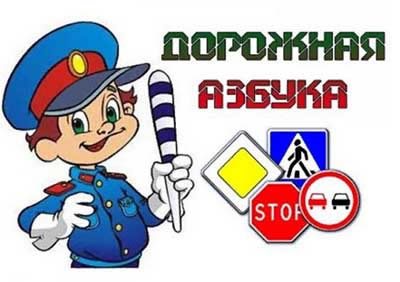
Bus game
“Buses” are teams of children: “driver” and “passengers”. Flags are placed 6-7m from each team. On the command “March!” The first players quickly walk (it is forbidden to run) to their flags, go around them and return to the columns, where they are joined by the second ones and together they again make the same path, etc. The players hold each other's elbows. When the bus (front player - “driver”) returns to its place with a full complement of passengers, it must sound a whistle. The team that arrives at the final stop first wins.
Game "Traffic inspector and drivers"
5-6 people will take part in the game. On the playing area, 4-5 parallel lines are drawn with chalk, indicating the stages of movement. Players (drivers) place their cars (chairs) behind the last line and sit on them. Drivers have driver's license coupons (cardboard rectangles). A traffic inspector sits on the opposite side of the platform, facing the drivers, with road signs and scissors in his hands. These scissors are needed to cut out the license of an offending driver.
The traffic inspector shows road signs one by one. The driver, who has correctly explained what the sign requires, advances to the next line. The driver, who failed to explain this, receives a puncture (a corner of the driver's license is cut off with scissors) and a remark from the traffic inspector; his car remains in place. A player who receives four punctures is eliminated from the game. A driver who passes all stages without any comments becomes a traffic inspector, and a traffic inspector becomes a driver. The game repeats itself. Drivers who are eliminated from the game receive new driver's license coupons and are included in the game.
Game "Be careful"
Children remember what to do and when to do it. They walk in a circle and carefully listen to the signals of the traffic controller. At the signal: “Traffic light!” - we stand still; at the signal: “Transition!” - we walk; at the signal: “Car!” - We hold the steering wheel in our hands.
Game "Funny Tram"
We are cheerful trams, We don’t jump like bunnies, We ride on the rails together. Hey, come sit with us if you want! Children are divided into two teams. One team - trams. The tram driver holds a hoop in his hands. The second team is passengers, they take their places at the bus stop. Each tram can carry only one passenger, who takes his place in the hoop. The final stop is on the opposite side of the hall.
Attraction game “Attention, pedestrian”
To play this game you need three wands, painted in three colors of traffic lights. The traffic controller - the teacher - shows the children lined up in a line in front of him, alternately one of the three batons. Participants in the game take a step back when they see a red rod, stand when they see a yellow one, and two steps forward when they see a green one. The traffic controller fines the one who makes a mistake and deprives him of the right to take part in the game. The winner is the one who never makes a mistake. The winner is awarded a badge, postcard, book, etc.
Game "Garage"
At the corners of the site, 5-8 large circles are drawn - parking lots, garages for cars. Inside each parking lot, draw 2-5 circles - cars (you can put hoops). The total number of machines should be 5-8 less than the number of players. Children walk in a circle, holding hands, to the sound of music. As soon as the music ends, everyone runs to the garages and takes a seat in any of the cars. Those left without a place are eliminated from the game.
Game "Trucks"
The players hold car steering wheels in their hands - these are trucks. They need to deliver urgent cargo. Each person has a small bag of sawdust or sand on their head. Who can run fast enough to overtake all their rivals and not drop the load - this bag?
Game "Road, transport, passenger"
Children stand in a circle, and a traffic controller stands in the middle of it. He throws the ball to one of the players, while saying one word: road, transport, pedestrian, passenger. If the driver said the word “Road!”, he who caught the ball must quickly name a word related to the road. For example: street, sidewalk, curb, etc. To the word “Transport!” the player answers with the name of any vehicle; to the word “Pedestrian!” you can answer - traffic light, crossing, etc. The ball is then returned to the traffic controller. The wrong player is eliminated from the game.
Game "Road - non-road"
The playing field is drawn in a line, where each line is separated from the other by one step (you can play on a wide ladder), the players stand behind the last line and drive the ball one by one, calling out different words. If “road” sounds, skip or discard; if the player’s actions correspond to the named word, the player moves to the next line (to the next step). The one who crosses the last line first wins and becomes the driver.
Game "Hare"
A bunny rides on a tram, A bunny rides, he reasons: “If I bought a ticket, Who am I: a hare or not?” The tram “conductor” sells tickets to passengers who sit on chairs – the seats on the tram. But there are one fewer chairs than passengers. As soon as all the tickets are sold and someone is left without a ticket, the conductor catches up with this “hare” and runs away.
Game “Remember the traffic controller’s signals”
Here at the post at any time there is a familiar guard. He controls everyone at once, who is in front of him on the pavement. No one in the world can do that with one movement of the hand. Stop the flow of passers-by and let trucks pass. Children are divided into teams, and a captain is chosen for each of them. The teams are located behind the starting lines - one opposite the other. The distance between teams is 20-30m.
In the middle of the site, between two lines that limit a strip 2-3 m wide, flags are laid out in a checkerboard pattern. At a signal from the traffic controller (red light - arms extended to the sides or lowered - stop; yellow light - right hand with a baton in front of the chest - get ready; green light - the traffic controller is facing the pedestrians sideways, arms extended to the sides or lowered - go) players quickly run up to the flags and try to collect as many of them as possible.
After a set time, at the command of the traffic controller, the children return to their places and quickly form a line. Captains collect and count the flags brought by their players. One point is awarded for each flag. The team with the most points wins.
Rules of the game: 1. During the run, the player is allowed to collect any number of flags lying on the ground.
2. It is prohibited to take away flags from each other.
3. You cannot step beyond the lines limiting the space for flags.
4. Team captains play on equal terms with everyone.
Game "Walking along the path"
Players walk along the path, naming at each step, for example, the names of road signs, etc. The one who takes the most steps and names the most words wins. The game “Whoever is named, catches it.” The players sit in a circle. In the center is a traffic controller (driver). He calls the name of one of those standing in a circle and throws the ball to him. The person named catches the ball, names some type of transport and throws the ball to the traffic controller. The one who did not catch the ball or did not say the word becomes the driver. The winner is the one who has never been a traffic controller.
Game "Catch - don't catch"
Participants in the game, 6-8 people, line up half a step from each other. The leader is 4-5 steps away from the players with the ball, throws it to any player, while pronouncing words, for example: “road”, “crossing”, “road sign”, etc. (in this case the ball should not be caught). The one who makes a mistake takes a step forward, but continues to play. If he makes a second mistake, he is eliminated from the game. It is very important that the driver first says the word and then throws the ball.
Game "Name the Sixth"
Several people play. The driver turns to someone to whom he throws the ball into his hands: “Name the sixth” - and lists, for example, five types of transport (or road signs, etc.). The person asked to continue the list must catch the ball and quickly add another name without repeating what was listed before. If the words follow immediately, the person answering begins to ask questions; if not, the driver remains the same.
Game "Find the Rod"
Before the game starts, the teacher hides the traffic control rod in plain sight. The players stand in a line or column, one at a time. At the leader’s signal, the players move in a column, one at a time, around the hall, and everyone tries to be the first to notice the hidden object. The player who sees the object first puts his hands on his belt and continues walking, without showing others where the hidden object is. The teacher, to make sure that the player really found the object, can quietly ask him. The game ends when all or most of the players have found the item. The player, having noticed a hidden object, must not stop, slow down, touch or in any other way indicate to other players the location of the hidden object.
Game "Find a Pair"
The players are given strips of paper with images of road signs. Without talking, everyone must find a mate, that is, a partner with the same picture. Couples stand in a circle. Complications: each pair tells what their road sign means.
Game "Unusual Road Sign"
In this game, children are asked to come up with an unusual road sign. You need to choose one of the objects from the surrounding world and try to transfer its properties to a road sign. At the same time, the most fantastic, most incredible options are possible. The teacher invites the children to think of some object of living or inanimate nature (cat, tree, flower, house, etc.). The teacher asks: “Could an unusual road sign somehow resemble a cat?” The children answer: “Maybe!”
Game "Traffic Lights"
The traffic light is red! The path is dangerous - there is no passage! And if the yellow light is on, he says “get ready.” Green flashed ahead - the way is clear - cross. In the game, all children are “pedestrians”. When the traffic controller shows a yellow light at the traffic light, all the children line up and get ready; when the green light turns on, they can walk, run, and jump around the entire hall; when the light is red, everyone freezes in place. The one who makes a mistake is eliminated from the game. When crossing the street, follow the traffic lights.
Game "Spiderweb"
Children sit in a circle. The driver, a traffic controller, has a ball of thread in his hands. He throws a ball to any of the children and names the cause of accidents on the roads: “Sasha, walking along the roadway when there is a sidewalk is dangerous.” Sasha holds the thread and throws the ball further: “Sergey! Leaving a stationary car unexpectedly can lead to an accident.” Sergei holds the thread and throws the ball further: “Olya! Children playing on the roadway is very dangerous.” When all the children take part in the game, they will have a “web” in their hands and a long story about the causes of accidents on the roads.
Game "Trip to Moscow"
To play you need chairs - one less than there are players. The chairs are placed tightly in a circle. One next to the other, with the seats facing out. Each player takes an empty seat. The driver does not have a chair. He walks around the players, holding a flag in his hand and says: “I’m going to Moscow, I invite those who wish.” All the guys one by one join him. The driver says: “We are going to Moscow by bus (train, plane),” he announces (the running slows down). "Attention, stop!" — the driver’s command is suddenly heard. At this command, everyone runs to the chairs. Everyone tries to occupy any free space. The driver also tries to take a seat. The one who is left without a chair becomes the driver, gets a flag and repeats the game. The driver can take the children away from the chairs, lead them across the hall, etc. and give the command “Landing!” unexpectedly, anywhere.
Game "Crossroads"
The leader stands in the center of the intersection - this is a traffic light. Children are divided into two groups - pedestrians and cars. The presenter's whistle sounds. The intersection comes to life: pedestrians walk, vehicles move. If a violation of the Traffic Rules is allowed, the presenter whistles and calls the name of the violator. He leaves the game. Those who have no mistakes win. A motor rally on tricycles and scooters will be organized for the winners.
Game "Search for the Wand"
Two chairs are placed at a distance of 8-10m. one from the other and a rod is placed on each. The players stand near the chairs, facing each other, and are blindfolded. At the leader’s signal, each of them must go forward, go around his friend’s chair and, returning back, find his baton and knock it on the chair. The one who completes this first wins.
Game "Different Cars"
The leading traffic controller exclaims: “Trucks!” - and the trucks quickly drive towards their line. And passenger cars follow them, trying to make them look bad. The presenter remembers (or someone notes) the number of those covered. It’s the turn of the passenger cars to go to their road. And among them there will be losers who were overtaken by trucks. And so on several times. The presenter does not necessarily call the commands strictly in order - it will be more interesting if he unexpectedly calls one several times in a row. It is only important that the total number of trips for trucks and cars ends up being the same. To create more tension in the game, team names should be pronounced syllable by syllable. Here it sounds: “Ma-shi-ny easy...”.
Game "traffic controller"
While walking in a column, one at a time, the teacher (he goes first) changes the position of his hands: to the side, on the waist, up, behind the head, behind the back. Children perform all the movements behind him, except for one - hands on the belt. This movement is prohibited. The one who makes a mistake leaves the ranks, stands at the end of the column and continues the game. After some time, another movement is declared prohibited. Physical education minute The guard stands stubbornly (we walk in place) He waves to people: Don’t go! (moves hands to the sides, up, to the sides, down) Here the cars drive straight (hands in front of you) Pedestrian, just wait! (arms to the sides) Look: he smiled (hands on his belt) Invites us to walk (we walk in place) You cars, don’t rush (claps your hands) Let pedestrians pass (jumping in place)
Game "Let's rent a license"
5-7 people will take part in the game: a traffic inspector and drivers. The players choose a driver (traffic inspector). He is given a road sign (from the "Wall Road Signs" set), with its meaning written on the back of the sign. The traffic inspector shows road signs, changing them one by one, and drivers explain the meaning of the signs. For the correct answer they receive a point (they are given a colored token, a piece of cardboard). At the end of the game, it is calculated which of the drivers received the most tokens. He is awarded the title of 1st class driver, others - 2nd and 3rd class drivers, respectively. The player who takes first place becomes a traffic inspector. The game repeats itself.
Game "Collect the picture"
From each team (“Traffic Light”, “Car”, “Pedestrian”, etc.), a player is selected to participate in the game using a counting rhyme. It is necessary to collect different parts of the picture on the road to get a picture with the same image as the name of the team.
Taxi game
A group of children is divided into two pairs. Each pair (“Taxi”) stands inside one hoop (“Taxi”). Each child holds his or her half of the circle (usually at waist or shoulder level). Children run around standing inside hoops while music plays. The two children must move at the same speed and in the same direction. Every time the music stops, children from two different hoops join together. The game continues until the maximum number of children fit inside the hoops (up to 6-8 people).
Game “Move slower...”
The driver stands on one side of the playing field, the players are at the other end, the driver turns away and says: “Quiet - you will continue, one, two, three, stop,” and turns around, the players who are running towards the driver at this moment must freeze, the one who did not manage to stop in time returns to the starting line. The winner who is the first to reach the driver's territory becomes the driver himself. The whole point of interest lies in the fact that the phrase can be cut off in any way you like (an element of surprise is introduced), but the last word should still be “stop”, only after which the driver can turn around.
Game "Traffic Light"
A fun outdoor game for children from four years old that develops attentiveness and reaction. It can be played outdoors at any time of the year.
Game description
Two lines are marked on the ground, 4-5 meters from each other, the leader (traffic light) stands between these lines, and all players must stand behind one of them. The presenter, turning away from the players, names a color and all the players who have that color in their clothes move to the other line. Those who do not have clothes of this color must run past the “traffic light,” and he, in turn, must slap one of the “violators.” The “violator”, spotted by the “traffic light”, becomes the leader.
Rules of the game
Draw two lines on the ground. A traffic light leader is appointed, he must stand between these lines. Players stand behind one of the lines. The “traffic light” turns away from the players and names any color; players with that color of clothing move to the other line. All those remaining become “violators” and must run past the “traffic light” to another line. The “violator”, who is insulted by the leader, becomes the next leader



